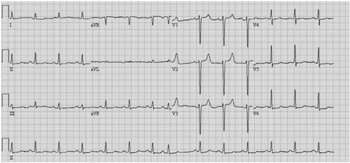Premature atrial contraction
| Premature atrial contraction | |
|---|---|
| Other names: Supraventricular extra systole (SVES), atrial premature complexes (APC), atrial premature beats (APB)[1] | |
| Two PACs as seen on a rhythm strip | |
| Specialty | Cardiology |
| Symptoms | None, feeling of skipped beat[2] |
| Causes | Unclear, coronary artery disease, valvular heart disease, hypertrophic cardiomyopathy[1] |
| Risk factors | Beta blockers, digoxin, alcohol, pregnancy[1] |
| Diagnostic method | Electrocardiogram (ECG)[1] |
| Differential diagnosis | Premature junctional contractions, premature ventricular contractions, panic attacks |
| Treatment | Reassurance, beta blockers[1] |
| Prognosis | Generally not serious[1] |
| Frequency | Common[1] |
Premature atrial contractions (PACs) are early extra beats that arise from the atria of the heart but not the sinoatrial node.[1] They often result in no symptoms but may be felt as a "skipped beat" in the chest.[2] Other symptoms may include anxiety or shortness of breath.[1] The condition is generally not serious, though frequent PACs are a risk factor for atrial fibrillation and atrial flutter.[1]
Often the cause is unclear, though they may occur as a result of coronary artery disease, valvular heart disease, and hypertrophic cardiomyopathy.[1] Risk factors include taking beta blockers or digoxin, alcohol, and pregnancy.[1] Diagnosis is generally by electrocardiogram (ECG), which shows an early but normal QRS complex.[1] In those with frequent PACs an ultrasound of the heart is recommended.[1]
In most cases, no treatment other than reassurance and avoiding triggers is needed.[2] In those who are bothered by the symptoms, beta blockers may be used.[1] Occasionally catheter ablation may be carried out.[1] PACs are common in all age groups.[1]
Signs and symptoms
Symptoms vary from none to anxiety or shortness of breath.[1]
Risk factors
Hypertension, or abnormally high blood pressure, often signifies an elevated level of both psychological and physiological stress. Often, hypertension goes hand in hand with various atrial fibrillations including premature atrial contractions (PACs).[3] Additional factors that may contribute to spontaneous premature atrial contractions could be:[4]
- Increased age
- Abnormal body height
- History of cardiovascular disease (CV)
- Abnormal ANP levels
- Elevated cholesterol
Diagnosis
Premature atrial contractions are typically diagnosed with an electrocardiogram, Holter monitor, or cardiac event monitor.
Electrocardiogram

On an electrocardiogram (ECG), PACs are characterized by an abnormally shaped P wave. Since the premature beat initiates outside the sinoatrial node, the associated P wave appears different from those seen in normal sinus rhythm. Typically, the atrial impulse propagates normally through the atrioventricular node and into the cardiac ventricles, resulting in a normal, narrow QRS complex. However, if the atrial beat is premature enough, it may reach the atrioventricular node during its refractory period, in which case it will not be conducted to the ventricle and there will be no QRS complex following the P wave.
Differential diagnosis
A supraventricular extrasystole (SVES) is an premature electrical impulse in the heart, generated above the level of the ventricle. This can be either a premature atrial contraction or a premature impulse from the atrioventricular node. SVES should be viewed in contrast to a premature ventricular contraction that has a ventricular origin and the associated QRS change. Instead of the electrical impulse beginning in the sinoatrial (SA) node and propagating to the atrioventricular (AV) node, the signal is conducted both to the ventricle and back to the SA node where the signal began.[5]
Treatment
Premature atrial contractions are often benign, requiring no treatment. Occasionally, the patient having the PAC will find these symptoms bothersome, in which case the doctor may treat the PACs. Sometimes the PACs can indicate heart disease or an increased risk for other cardiac arrhythmias. In this case the underlying cause is treated. Often a beta blocker will be prescribed for symptomatic PACs.[6]
Prognosis
In otherwise healthy patients, occasional premature atrial contractions are a common and normal finding and do not indicate any particular health risk. Rarely, in patients with other underlying structural heart problems, PACs can trigger a more serious arrhythmia such as atrial flutter or atrial fibrillation.[7] In otherwise healthy people, PACs usually disappear with adolescence.
References
- ↑ 1.00 1.01 1.02 1.03 1.04 1.05 1.06 1.07 1.08 1.09 1.10 1.11 1.12 1.13 1.14 1.15 1.16 1.17 Heaton, J; Yandrapalli, S (January 2020). "Premature Atrial Contractions". PMID 32644630.
{{cite journal}}: Cite journal requires|journal=(help) - ↑ 2.0 2.1 2.2 "Types of Arrhythmia". July 1, 2011. Archived from the original on 7 June 2015. Retrieved 19 March 2015.
- ↑ Healy, Jeff (2003). "Atrial fibrillation: hypertension as a causative agent, risk factor for complications, and potential therapeutic target". The American Journal of Cardiology. 91 (10): 9–14. doi:10.1016/S0002-9149(03)00227-3.
- ↑ Lin, Chin-Yu; Lin, Yenn-Jiang; Chen, Yun-Yu; Chang, Shih-Lin; Lo, Li-Wei; Chao, Tze-Fan; Chung, Fa-Po; Hu, Yu-Feng; Chong, Eric (2015-08-27). "Prognostic Significance of Premature Atrial Complexes Burden in Prediction of Long-Term Outcome". Journal of the American Heart Association: Cardiovascular and Cerebrovascular Disease. 4 (9): e002192. doi:10.1161/JAHA.115.002192. ISSN 2047-9980. PMC 4599506. PMID 26316525.
- ↑ Ernst., Mutschler (1995-01-01). Drug actions : basic principles and theraputic aspects. Medpharm Scientific Publishers. ISBN 978-0849377747. OCLC 28854659.
- ↑ Hueston, Kesh A. Hebbar|William J. (2002-06-15). "Management of Common Arrhythmias: Part I. Supraventricular Arrhythmias". American Family Physician. 65 (12): 2479–86. PMID 12086237. Archived from the original on 2017-03-30. Retrieved 2017-03-29.
- ↑ Jensen, Thomas J.; Haarbo, Jens; Pehrson, Steen M.; Thomsen, Bloch (2004-04-01). "Impact of premature atrial contractions in atrial fibrillation". Pacing and Clinical Electrophysiology: PACE. 27 (4): 447–452. doi:10.1111/j.1540-8159.2004.00462.x. ISSN 0147-8389. PMID 15078396.
External links
| Classification |
|---|